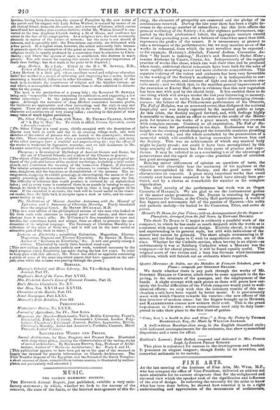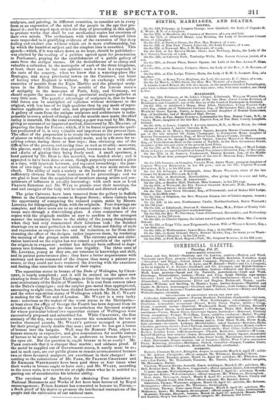FINE ARTS.
AT the last meeting of the Institute of Fine Arts, Mr. WTsE, M.P.„ who has accepted the office of Vice-President, delivered an address not more admirable for its earnest eloquence than for the enlightened and elevated view which the speaker took of the signification and influence. ofthe arts of design. In enforcing the necessity for the artist to know what has been done before, he showed how essential it is to a right understanding and appreciatienv of the monuments of architectarer sculpture, and painting, in different countries, to consider art in every form as an expression of the mind of the people in the age that pro- duced it ; and he urged upon artists the duty of proceeding in this spirit, to produce works that shall be not mechanical copies but creations of their own minds. The enthusiasm with which these enlarged ideas were responded to is gratifying evidence of the extension of that deep feeling and exalted aim without which art is mere craftsmanship, but by which the humblest subject and the simplest idea is ennobled. This speech—which, if it was taken down as we hope, should be published— was elicited by the reading of a petition agreed upon for presentation to Parliament, praying for the establishment of a public gallery of casts from the antique statues. Of the desirableness of so cheap and valuable a collection in the metropolis of each of the three kingdoms, at least, there can be but one opinion : such a want is a reproach to the taste of the country, when we know that a watering-place like Boulogne, and many provincial towns on the Continent, can boast of having what England is without. By an exchange with other countries of moulds from the Elgin Marbles and the principal sculp- tures in the British Museum, for moulds of the famous statues of antiquity in the museums of Paris, Italy, and Germany, we should acquire the means of forming provincial sculpture-galleries at very little cost. The peculiar advantage of sculpture is, that its beau- tiful forms can be multiplied ad infinitum without detriment to the original, with less loss of its high qualities than by any mode of repro- duction applicable to other arts, and proportionably at less expense. A gallery of casts from the antique sculpture and architecture is indis- pensable to every school of design ; and the moulds once made, the chief outlay is incurred. On the same evening, a paper was read by Mr. Buss, giving an account of an improved method, discovered by Mr. HEAPHY, of preparing the lime for Fresco ; which, if it be found to possess the quali- ties predicated of it, is very valuable and important at the present time. The effect of the preparation is to retain the intonaco (or outer surface of plaster on which the fresco is painted) moist, and in a fit state for re- ceiving colour, during three or four days ; thus obviating one of the difficulties of the process, and saving time as well as trouble : moreover, this plaster, made with lime thus prepared, becomes as bard as marble, and admits of glazing-tints being freely used. A small specimen, a head painted by Mr. Buss in this material, was handed about ; and it appeared to have been done at once, though purposely executed a piece at a time, with intervals between, and repeated retouchings : the junc- tion of two days' work was not visible, though it was made across the cheek. The utility of such a society as the Institute of Fine Arts is sufficiently obvious from these instances of its proceedings ; and we are glad to hear that the acquisition of members among artists and con- noisseurs of influence is steadily increasing : with such men as Lord FitAticts EGERTON and Mr. WYSE to preside over their meetings, the zeal and energies of the body will be controlled and directed aright.
The prize Cartoons have been removed from the gallery in Suffolk Street to the Cosmorama-rooms in Regent Street ; where visiters have the opportunity of comparing the reduced copies, made by Messrs. LINNELL for lithographing from, with the originals. Four drawings are complete, and three more are in an advanced state : they look like car- toons seen through a diminishing-glass. A close comparison of the copies with the originals enables us now to confirm in the strongest manner the testimony borne to the ability of the young draughtsmen when they had only commenced their laborious task : the finished drawings are as near perfection in accuracy of form and fidelity of style and expression as copies can be ; and the reduction, so far from dete- riorating the effect of the designs, rather improves them, by rendering the massing of the groups more solid. The extreme pains and elabo- ration bestowed on the copies has not caused a particle of the spirit of the originals to evaporate ; neither has delicacy been suffered to dege- nerate into littleness, nor precision into frigidity. The three sons of Mr. LINNELL, young as they are, are veterans in knowledge and skill, and in patient perseverance also : they have a better acquaintance with anatomy and more command of the crayon than many a painter pos- sesses or they could not have rendered the drawing with the exactness andleeling that constitute the value of their copies.
The equestrian statue in bronze of the Duke of Wellington, by CRAW- TREY, is nearly completed ; and it will be erected on the space now clearing in front of the Royal Exchange, in time for inauguration on the next anniversary of the Battle of Waterloo. It is cast from cannon taken in the Duke's campaigns ; and the surplus gun-metal thus appropriated, amounting to eight tons, has been divided between the Nelson Memorial and the other equestrian statue of Wellington which Mr. M. C. Witterr is making for the West end of London. Mr. Wy.s.yr is a very lucky man : notorious as the maker of the worst statue in the Metropolis- at-least since the effigy of George the Fourth has been deposed from its elevation at King's Cross—he was nevertheless the favoured sculptor for whose particular behoof two equestrian statues of Wellington were successively proposed and subscribed for. While CHANTREY, the first statuary of the day, was content to execute his commission for ten or twelve thousand pounds, Mr. NVYATT'S patrons managed to procure for their protégé nearly double that sum ; and now he has got a bonus of bronze into the bargain. Well may Sir ROBERT PEEL object to bronze statuary as expensive, and give commissions for marble statues of heroes to be set up under cover, in preference to bronze figures in the open air. But the question is, ought bronze to be so costly ? Mr. PARK contends that it is cheaper than marble ; and adduces proof. If the metal be supplied out of Government-stores, it surely must be so ; and in such case, are our public places to remain unornamented because two or three favoured sculptors are exorbitant in their charges? Ac- cording to the calculations of Mr. PARK, Sir FRANCIS CHASTEST and Sir RICHARD WESTMACOTT have been paid three or four times what their works in bronze ought to have cost ; and Mr. WYATT, according to the same ratio, is to receive six or eight times what he is entitled to ; putting out of consideration his inferior ability.
The- exertions of the Society for obtaining Free Admission to National Monuments and Works of Art have been honoured by Royal encouragement: Prince ALBERT has consented to become its Patron,— a flesh proof of his desire to promote the intellectual recreations of the people and the cultivation of our national taste.



























 Previous page
Previous page